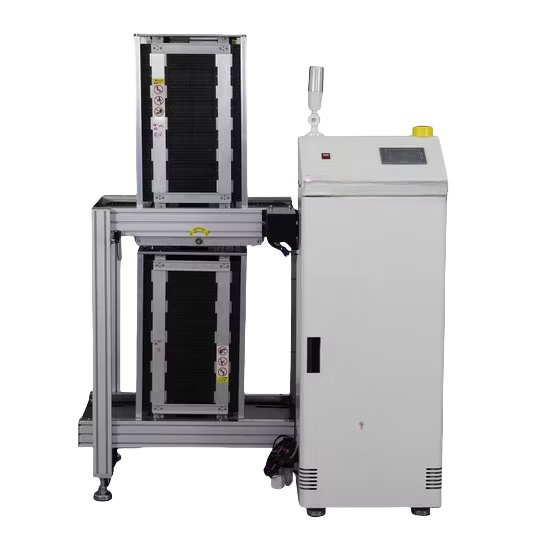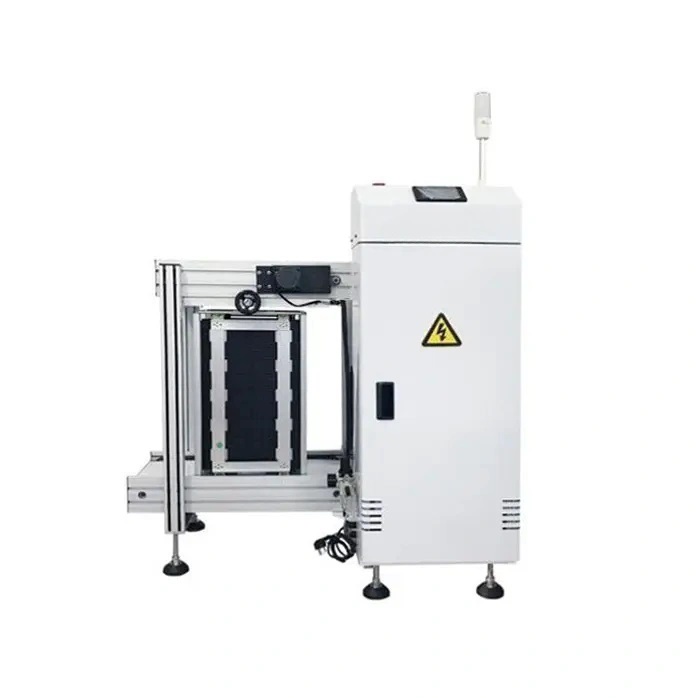Content Menu
● Understanding PCB Magazine Loaders
>> How Do PCB Magazine Loaders Work?
● Types of PCB Magazine Loaders
>> Key Features to Consider
● Advantages of Using PCB Magazine Loaders
● Choosing a PCB Magazine Loader Supplier
● Conclusion
>> Frequently Asked Questions
Understanding PCB Magazine Loaders
PCB magazine loaders are automated devices designed to handle the loading of PCBs onto conveyor systems in manufacturing settings. They are particularly valuable in Surface Mount Technology (SMT) environments, where precision and speed are crucial. The loaders can accommodate different sizes and types of magazines, making them versatile for various production needs.
How Do PCB Magazine Loaders Work?
PCB magazine loaders operate by using a series of mechanical components to lift and transfer PCBs from a stacked magazine onto a conveyor belt. The process typically involves:
1. Magazine Loading: The loader is equipped with a magazine that holds multiple PCBs.
2. Automatic Transfer: Using pneumatic or mechanical systems, the loader pushes or lifts individual PCBs from the magazine onto the conveyor.
3. Control Systems: Most modern loaders come with programmable logic controllers (PLCs) that allow for precise control over loading speed, positioning, and other operational parameters.

Types of PCB Magazine Loaders
There are several types of PCB magazine loaders available on the market, each designed to meet specific production requirements:
- Standard Loaders: Typically handle PCBs up to 250mm wide.
- Mid-Size Loaders: Accommodate PCBs up to 300mm wide.
- Large Loaders: Designed for PCBs wider than 300mm, often customized based on client specifications.
Key Features to Consider
When selecting a PCB magazine loader, consider the following features:
- Size Compatibility: Ensure the loader can handle the specific dimensions of your PCBs.
- Loading Speed: Evaluate the time it takes to load each PCB; faster loaders can significantly enhance productivity.
- Control Interface: Look for user-friendly interfaces that allow easy programming and operation.
- Durability and Maintenance: Choose loaders made from high-quality materials that require minimal maintenance.
Advantages of Using PCB Magazine Loaders
Incorporating PCB magazine loaders into your production line offers numerous benefits:
1. Increased Efficiency: Automating the loading process reduces downtime and increases overall production speed.
2. Reduced Labor Costs: With less manual handling required, companies can save on labor costs and reduce human error.
3. Improved Safety: Automating potentially hazardous tasks minimizes risks associated with manual handling.
4. Consistent Quality: Automated systems provide uniformity in loading, which enhances product quality.
Choosing a PCB Magazine Loader Supplier
Selecting the right supplier is crucial for ensuring you receive high-quality equipment that meets your production needs. Here are some tips for choosing a reliable PCB magazine loader supplier:
- Experience and Reputation: Look for suppliers with a proven track record in manufacturing and supplying PCB loaders.
- Customization Options: A good supplier should offer customization options to tailor the equipment to your specific requirements.
- Technical Support and Service: Ensure that the supplier provides adequate support for installation, maintenance, and troubleshooting.
- Warranty and After-Sales Service: Check if they offer warranties on their products and reliable after-sales service.
Conclusion
The implementation of a PCB magazine loader can transform your production line by enhancing efficiency, reducing costs, and improving safety. By carefully considering your options and selecting a reputable supplier, you can ensure that you invest in equipment that meets your operational needs.

Frequently Asked Questions
1. What is a PCB magazine loader?
A PCB magazine loader is an automated device used to load printed circuit boards onto production lines efficiently.
2. How does a PCB magazine loader improve production efficiency?
It automates the loading process, reducing manual labor and downtime while increasing throughput.
3. What should I look for in a PCB magazine loader supplier?
Consider their experience, customization options, technical support, warranty offerings, and reputation.
4. Can I customize my PCB magazine loader?
Yes, many suppliers offer customization to meet specific size or operational requirements.
5. What are the typical sizes of PCBs that loaders can handle?
Loaders typically handle sizes ranging from 250mm to over 300mm wide, depending on the model.



















